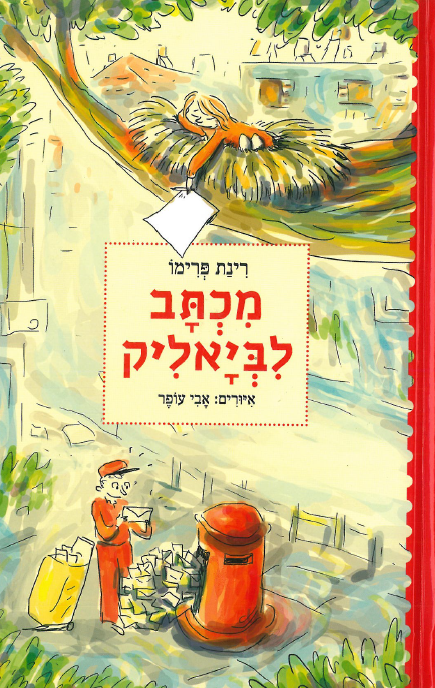מכתב לביאליק
מאת: רינת פרימו | איור: אבי עופר
תרגום לאנגלית של ההצעות לפעילות בחיק המשפחה
Lily studies a poem at school by Israel's national poet, Hayim Nahman Bialik, entitled Kan Zippor – A Bird's Nest. The poem speaks of a nest in the treetop containing three eggs, and the second verse reads:
וּבְכָל בֵּיצָה הַס, פֶּן תָּעִיר
Which means "And inside each egg, quiet, lest you wake it".
When Lily is asked to draw a picture related to the poem for homework, she wonders what a lestyouwakeit (in Hebrew, Haspentair) looks like and how she is to draw it. So she writes a letter to Bialik, and even gets a response!
This creative and amusing story about the naïve encounter between a young girl and the written word allows readers and listeners to get to know Hayim Nahman Bialik and his work.
"The bashful cannot learn"
(Ethics of the Fathers, 2:5)
Asking questions is a significant part of learning. Jewish tradition encourages us to ask questions at all ages, attributing great importance to questions in one's internalization process. We should always listen to children's questions, without feeling pressured to provide them with all the answers. Sometimes it is enough to encourage them to keep on asking, and accompany them as they seek out and discover the answers on their own.
In A Letter to Bialik, Lily is not ashamed to ask what a "lestyouwakeit" is. Let us follow in her footsteps and never stop asking questions…
Hayim Nahman Bialik (1873–1936)
National poet and author, Hayim Nahman Bialik, was engaged in a variety of literary practices: he wrote essays, stories, and poems for both children and adults; translated classics into Hebrew; adapted and edited the Aggadah stories found throughout the Talmud, and more. Among his books are Sefer HaAggadah (co-edited with Y.H. Ravnitzky), Vayehi Hayom, and the children's poetry collection entitled Shirim Ufizmonot Layeladim.
Bialik's work had formed a bridge between ancient Hebrew, not spoken for thousands of years, and the reborn language that started to be spoken in the Land of Israel during the late 19th century. By doing so, he greatly impacted Jewish modern culture. Although Bialik and his wife bore no children of their own, the national poet wrote many verses for children, of whom he was famously fond.
Family Activities:
- Have you or your child ever misconstrued certain words in poems or songs, just like Lily did? You may enjoy sharing these amusing memories with one another.
- Lily and her classmates learned this poem by heart. You may also want to try and learn the words to Kan Zippor, Yossi Bakinor, or a poem in English by heart. Did you find memorizing the words difficult? Sometimes it is easier to memorize song lyrics than verses of poetry.
- When Lily does not understand something, she is not ashamed to admit it and asks for help. Perhaps you would like to read the story together and encourage your child to ask about anything that is not clear to them (why does Bialik not reply to Lily himself? What do other difficult words in the poems mean?). Be sure to tell your child never to stop asking questions.
- In this day and age it seems everything is done online, and we rarely write letters anymore. Inspired by Lily's letter to Bialik, you may want to let your child write a letter and send it by mail. Maybe there is a question your child wants to ask their grandparent, aunt or uncle in a letter, which you can then slip into an addressed envelope, just like Lily did. You may enjoy going to the post box together and putting the letter in. your child will surely get a reply too.
- Nitzan writes the following to Lily: "Whoever reads or hears a poem can decide for themselves what it's about and what things look like… Think and decide for yourself what the lestoyouwakeit looks like." You might want to ask your child whether they would have been happy to receive such a response, or what they would have written back to Lily had they received her letter.
- You may enjoy looking at the illustration depicting Lily's drawing of the poem entitled Yossi Bakinor. Do you find it amusing? (Did you notice the sleepy car?) How would you illustrate this poem? You may want to look for various illustrations of the same poem together, and search for similarities and differences between them.
- Bialik wrote many other children's poems, such as Rutz Ben Susi, Nad Ned, and Tzilly VeGilly. You may want to look for them at home or in the local library, and read them together. Perhaps you could choose some of the ones your child likes best, have them draw them as they see fit, and create their very own, personally-illustrated Bialik poetry collection.
- Next time you're in Tel Aviv, you may enjoy visiting Israel's national poet's home, Beit Bialik, which has since been converted into a museum. Until then you can go there online, and take a look around Hayim Nahman Bialik's house. http://www.shimur.org/Bialik
Enjoy reading and discussing the book together!





